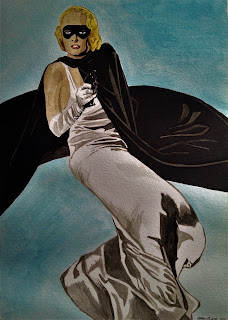LEGENDARY HEROES #29
THE DOMINO LADY
During the 1930s there were over 300 different pulp magazine titles published in America with subject matter that could appeal to most anyone, especially if you were a man. I've never seen any demographics to confirm this but I suspect that women were never a target audience. Which makes The Domino Lady quite unique in the history of the pulps, because she was the only costumed pulp heroine to star in her own series. Women were seldom the headliners in pulp stories. The Domino Lady first appeared in the May 1936 issue of Saucy Romantic Adventures. The magazine title was one of the "spicy pulps", a genre that featured risque short stories and covers that showcased women in a state of undress. Actually the stories were pretty tame by today's standards, but in the 1930s any story that had a woman semi-dressed or (heaven forbid) undressed in front of a man was considered pretty hot stuff. The stories were often about two-fisted heroes who faced deadly decisions while a beautiful, scantily clad woman was hanging in the balance.
The Domino Lady was in reality Ellen Patrick, a University of California - Berkeley educated socialite whose father, District Attorney Owen Patrick, is murdered. She seeks vengeance by donning a white evening gown with a black cloak and a domino mask and becoming the Domino Lady. She arms herself with a .45 automatic and a syringe full of knockout serum and sets out to avenge her father's death. But her greatest weapon proves to be her beauty which distracts and entrances the underworld characters that she meets, or at the very least causes them to underestimate her. After dealing with the criminal element then she would act like Robin Hood and steal their ill-gotten gains, from which she would take a small percentage for herself and donate the rest to charity accompanied by a calling card that would read "Compliments of the Domino Lady". She appeared in six short stories and all were published under the house name Lars Anderson that was used by the publisher Fiction Magazines. The identity of the real author is unknown. The story titles were "The Domino Lady Collects" (Saucy Romantic Adventures, May 1936), "The Domino Lady Doubles Back" (Saucy Romantic Adventures, June 1936), "The Domino Lady's Handicap" (Saucy Romantic Adventures, July 1936), "Emeralds Aboard" (Saucy Romantic Adventures, August 1936), "Black Legion" (Saucy Romantic Adventures, October 1936), and "The Domino Lady's Double" (Mystery Adventure Magazine, November 1936). All six of the original stories have been reprinted by Bold Venture Press with cover artwork provided by Jim Steranko.
The character of The Domino Lady is in the public domain and many publishers have created new stories of fiction and comics that feature her. In fact, she's more popular today than she was in 1936. The Audio Comics Company, a production company devoted to producing and distributing professional full-cast radio dramas adapted from independent comic books, graphic novels, web comics, and the occasional prose work, announced in 2011 that they would be doing a series of Domino Lady stories as part of their "pulp adventure" line. This was the first time that the character appeared on radio. The first episode "All's Fair in War" was written by Rich Harvey and recorded in San Francisco in November 2011 with Bay Area actress Karen Stilwell as the heroine. Three other stories were also written by Harvey and were published by Bold Venture Press in 2015 in a book titled "Domino Lady: Death on Exhibit". Bold Venture also printed a two-part Domino Lady story written by Rich Harvey in their magazine Awesome Tales (issue #6 2017 and #9 2018). The character of the Domino Lady paved the way for future crime-fighting heroines, most notably in comic books, like the Phantom Lady and Lady Luck. And to think that she began her career in the male-dominated world of pulp magazines.
Saucy Romantic Adventures, published by Fiction Magazines, should not be confused with another publisher Fiction House. Fiction House produced many noteworthy pulps and later comic books. I've been unable to find any information concerning Fiction Magazines, but as noted earlier they were considered one of the "spicy pulps". The writers of these stories were paid less even though the cover price was more expensive than typical pulp magazines. The publishers justified this citing smaller print runs and what the market would bear for lurid fiction that would be sold "under the counter". The covers were often so risque that newsstand vendors would never put the magazines on open display. The term "spicy pulps" was derived from four titles published by Harry Donenfeld beginning in 1925 - Spicy Adventure, Spicy Detective, Spicy Mystery, and Spicy Westerns. These magazines had the most lurid covers of any such pulp and Mr. Donenfeld found himself charged with obscenity and narrowly missed doing jail time. Having escaped jail Donenfeld toned down the image of his pulps and changed all the titles from "Spicy" to "Speed". Speed Westerns went on to become quite popular and was printed until 1948. Harry Donenfeld was a close friend of gangster Frank Costello and there have been rumors of Costello being a silent partner in Donenfeld's publishing history. Whenever Donenfeld looked to expand his operation funds were always available. He branched into printing and distribution and with partner Jack Liebowitz acquired a comic book company in 1938 called Detective Comics, or DC as it was known. The first new title that Donenfeld published was called Action Comics and it featured on the cover the creation of two young men from Cleveland that would become the biggest pop culture icon in the history of the world. The creation was called "Superman" and it would turn the comic book business into a multi-million dollar industry almost overnight. But that story will be in my next installment of Legendary Heroes.


.jpg)

.jpg)
Comments
Post a Comment